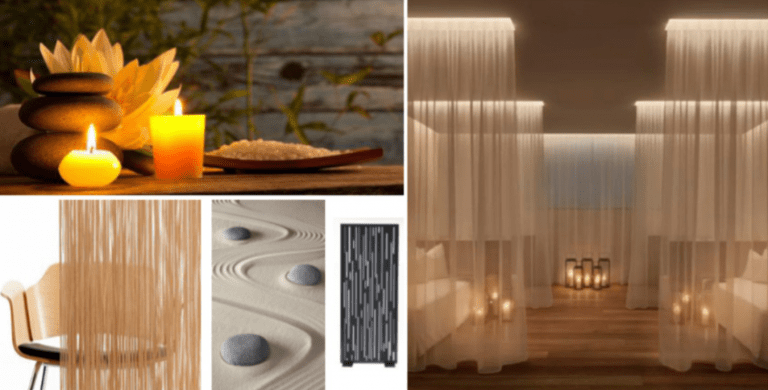
Sara Marberry

Doesn’t every nurse deserve a Zen Den?
I wrote a post about this a few years ago after I’d stumbled upon a quote from a CNO at Valley Hospital in Ridgewood, New Jersey, about the zen dens they had created as places where nurses could go for a break.
I’d also googled “zen den” and found a crowdfunding page nurses at Jacobs Medical Center in La Jolla, California, had created to raise money to furnish and equip their Zen Den.
What does a Zen Den Look Like, Feel Like?
UC San Diego Health had provided them with a dedicated space that was large enough for several nurses to meditate, do yoga, receive a massage, or even power nap. It had also funded the installation of calming lights on a dimmer switch, new paint, and an underwater mural.
These resourceful nurses had secured room dividers and a few furniture items at low cost from UC Health’s excess inventory. But they had 16 other things on their wishlist that would complete the space — things like massage chairs, yoga mats, artwork, etc.
Sadly, they only raised $2,400 of their $28,000 goal and the crowdfunding page has been paused. So I’m not sure where this project stands now.

Tranquility Room
Another model I discovered recently is the Tranquility Room at Sibley Memorial Hospital in Washington, D.C. A collaboration between musician and sound acoustician Yoko Sen, The Johns Hopkins Innovation Hub, and Gensler, it opened in 2018.
“Although Yoko and Hopkins set out to study noise in patient rooms, what they found in their research that the people most in need of focus, of relief from noise – were the care providers,” Tama Duffy Day, Principal, Health & Wellness Leader at Gensler told our webinar audience last week in a program we presented for the Nursing Institute for Healthcare Design.
Tama explained that it was through this lens that Yoko and Hopkins refocused their attention on defining the need for a staff room.
Staff Engagement is Key
The engagement with over 100 staff uncovered six categories of needs for a successful room: emotional recovery, physical comfort and relaxation, nourishing moments of pause, sensory detox and recharge, private safe space, and a sense of belonging.
“The findings indicated the need for a room that was dimly lit, with quiet sounds and comfortable furnishing, such as cozy chairs and yoga matts with access to water and aromatherapy,” said Tama. “The findings also revealed a need for semi-privacy and for the tranquility room to be located near the staffing unit.”
Design Requirements
What else? The design of the Tranquility Room had to:
- Meet the strict functional requirements of a hospital environment, without feeling like a hospital.
- Maintain infection control requirements for cleanability, without feeling cold and sterile or smell of disinfectant.
- Fulfill life safety restrictions around the use of drapery and fire-rated materials—without creating anything that looks like hospital cubicle curtains.
- Follow facility requirements around maintenance and durability—without the use of institutional, commercial-grade products.
- Operational Changes for a Successful Tranquility Room – Based on our experience success involves institutional changes and going beyond concept and intention.
Lessons Learned from the Tranquility Room
Other lessons learned that Tama shared were:
- You need an executive champion – a “change agent” that can invoke an institutional shift by accepting nurse fatigue, supporting resilience training of staff, and pushing the project forward.
- You need a budget, and a realistic one – start small, allow for iteration, and encourage staff feedback.
- You need a dedicated project manager – one who “owns” the mission while maintaining vision and oversight.
“The biggest obstacles to overcome were culture – like when the room is cleaned, who replenishes the water supply, and that it is not the residents’ sleep room,” said Tama. “But they are committed and have found solutions for all the questions they encounter.”
The Business Case
Tama also reported that the Tranquility Room had a budget of $200,000, which seems a bit high to me — especially since Gensler did the project pro-bono. But maybe not.
Yet when you compare that to the average cost to replace just one nurse ($52,000), it seems very little to spend to help nurses cope with the emotional and physical stresses of their jobs.
And who knows what the cost-savings might be for improved quality of care?
These are the arguments you give to administrators who are skeptical about creating and funding such a space in their hospital. The idea is so good and makes so much sense that it might also appeal to big donors in your community as well.
Because no nurse should have to cry in the bathroom. Ever.
More Posts About This Topic
“Tackling Clinician Burnout: Not Nurse Should Have to Cry in the Bathroom,” November 2019.
“How Can Design Help Prevent Clinician Burnout?” September 2019.
“Every Nurse Deserves a Zen Den,” February 2018.
Photo: Mood boards for Tranquility Room, courtesy of Gensler.
This column originally ran on Sara Marberry’s blog on Feb. 28. Marberry is a healthcare design expert who has written/edited five books and is a regular contributor to Healthcare Design magazine. Marberry also is a former Executive Vice President of the nonprofit Center for Health Design.
